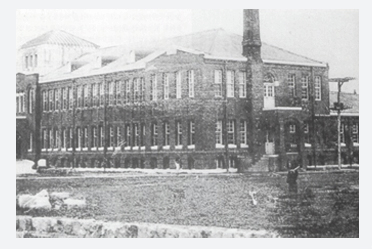
Location
1, Bumin-dong 2(i)-ga (Registered Cultural Heritage No. 41)
Building area
4452.75 ㎡ (2F, 1B)
This building served as Gyeongsangnam-do Provincial Office during Japan’s colonial rule, a provisional capital office during the Korean War, and was again Gyeongsangnam-do Provincial Office after the armistice treaty. It was later used as Busan District Court and Busan District Prosecutors’ Office after the provincial office was relocated. The building is a living witness to the sociopolitical changes in modern Korean history.
Busan was the only port city while Korea was annexed to Japan. It was not only the gate into Korea, but also the center of transportation, industry, education, and culture. Gyeongsangnam-do Provincial Office moved from Jinju to Busan for the aforementioned reasons.
The provincial office was temporarily stationed in a new building owned by Jahye Hospital in Bumin-jeong while a 28,879 square meter lot around the hospital was selected as the new location for the provincial office. The construction began in 1923 and the completed building opened by April 25, 1925. Korea was under the jurisdiction of the United States Army Military Government after its independence in 1945 until the Korean War broke out in 1950. The capital fled to Busan on August 18, 1950 because of the Korean War. During the first temporary capital phase, the main building was used for government administration while the two annex buildings each served as a congress and military-police strategy headquarters. The governor’s official residence was used by the president himself. This arrangement continued until Seoul was reclaimed on September 28 and the capital was restored to Seoul on October 27.
Busan became the provisional capital again after the January-Fourth Retreat as the Communist Chinese Army intervened in 1951. The building served the same purpose until July 27, 1953 when the armistice agreement ended the war. Seoul became the capital of Korea once more on August 15.
The building was used as Gyeongsangnam-do Provincial Office for 58 years and 3 months in total until the district office moved to Changwon in July 1983. It later served as Busan District Court and Busan District Prosecutors’ Office. After all the judicial offices moved to Geoje-dong, the building was sold off to Dong-A University in 2002.
The building is a two-story red brick structure that borrows elements from Western renaissance architecture. The decor on the front of the building is symmetric and meant to be viewed from the front. The finish of the front and sides were aesthetically pleasing. Originally a horizontal structure, more rooms have been added to the building over time. It went from having one courtyard to having two courtyards through the 1960s. When it became state registered cultural heritage in 2002, efforts were made to restore the building’s original form.
Now the building is one of the iconic modern buildings remaining in the Busan area aside from the provisional presidential home and governor’s official residence. It served as one of colonial Japan’s main offices where oppressive and discriminative policies were carried out against the Korean people and was also the government’s provisional capital office during the Korean War. It has witnessed the volatile modern history of Korea and for that reason, it is an architecturally and historically valuable cultural heritage.
